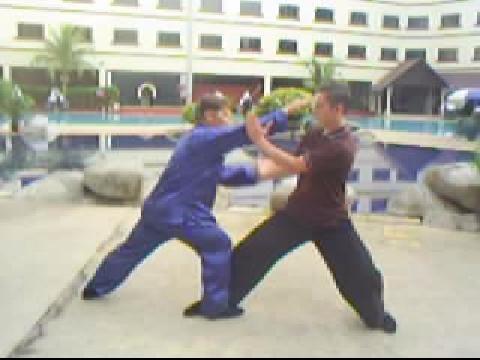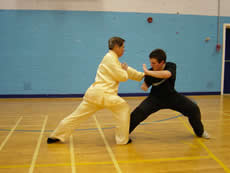A favorite topic of mine.. I hope you like it..
What is Chi Sao?
In the Fut Sao Wing Chun system, Chi Sao or Sticking Hands practice is not treated as simply a drill or sensitivity exercise as performed by some of the other Wing Chun lineages. In Fut Sao, the practice of Chi Sao, is treated and is equivalent to close quarter fighting. The skills one learns in Chi Sao practice will bring the practitioner to a higher level of development in his art. When one trains in Chi Sao one is not simply practicing a purely physical art but something that is also energy oriented and spiritual as well. When one concentrates on drills or applications one can clearly see that the practice becomes purely a physical and limits development in other areas. As one progresses in Chi Sao, one comes to realize it is not all about fighting but rather knowing yourself and your opponent. When one has reached a high level of proficiency in Chi Sao, the practice of simple drills and applications has almost no functionality. When practicing Chi Sao at such a high level all applications become possible. As mentioned earlier, if one just trains applications and drills he is only training the physical and not the energy side of the art which has no application yet is contained in all applications.
I hear all the time people say, "if your attacked on the street no one will Chi Sao you." Of course they will not Chi Sao you as Chi Sao is a way of training and an attack on your life is another matter. It seems to me people do not really understand the purpose of Chi Sao training, but something one has to realize is what one does in ones training is designed to build and develop real skills which can be applied at will. Chi Sao gives one the means necessary to reach that level of skill of which I am writing of. When you Chi Sao with your partner it is more like the testing grounds of an actual fight. One does not need to pummel your partner into the ground in order to see if what you've learned has any real value. Chi Sao is about control. If I can control myself and my partner during Chi Sao training then I know I have already won and do not need to go any further. In a real fight it will be over very quick. Once a move has been made it will have already ended and either I'll have survived or not. There is no playing; there are no points as seen in Chi Sao competitions.
Another point a lot of people seem to believe is that Chi Sao is merely "the rolling of the hands". Simply put, Chi Sao is not in the rolling, the contact point or the ability to always stick to the bridge. This brings me to another point, that Chi Sao "is not about always sticking or chasing the hand". It's not, as mentioned earlier it's about control. Chi Sao is found in any type of attack and the defense that one deploys in a real fight scenario. Chi Sao does not have to look a certain way. Again, the essence of Chi Sao is about control. Therefore, if I can control myself and your actions I'm using Chi Sao. WCK is very much based on maintaining a bridge which is conducive to Chi Sao training. Chi Sao training has many advantages over sparring. Most styles practice sparring from a non bridge non contact point. As sparring is also a good way to test and develop one's skills it is not the preferred way in Fut Sao Wing Chun system. Since Wing Chun is about controlled infighting it makes sense to use Chi Sao as a platform to test ones skills. Staying close and maintaining a bridge has an advantage over sparring where contact is lost. For a Wing Chun practitioner to be able to maintain a bridge is to his advantage while to someone like a boxer it is not. In fighting arts like Muay Thai or Western Boxing the idea of controlling the bridge is not part of the training, so Chi Sao is not needed for these types of arts. The advantage when you train with your partner in Chi Sao is that one does not need to gear-up as it is very safe to train granted that one has control. In sparring you must gear-up as there is no control and the idea is to pummel the opponent or score points as in point fighting. In Chi Sao, if practiced correctly, one can know he could have been hit without actually being hit. On the other hand, in sparring this is not possible one must hit the opponent. For beginners, psychologically, sparring can have negative effects due to the fear of being hit, and can ultimately affect their confidence and martial arts development.
--
Sifu Michael Mc Ilwrath
What is Chi Sao?
In the Fut Sao Wing Chun system, Chi Sao or Sticking Hands practice is not treated as simply a drill or sensitivity exercise as performed by some of the other Wing Chun lineages. In Fut Sao, the practice of Chi Sao, is treated and is equivalent to close quarter fighting. The skills one learns in Chi Sao practice will bring the practitioner to a higher level of development in his art. When one trains in Chi Sao one is not simply practicing a purely physical art but something that is also energy oriented and spiritual as well. When one concentrates on drills or applications one can clearly see that the practice becomes purely a physical and limits development in other areas. As one progresses in Chi Sao, one comes to realize it is not all about fighting but rather knowing yourself and your opponent. When one has reached a high level of proficiency in Chi Sao, the practice of simple drills and applications has almost no functionality. When practicing Chi Sao at such a high level all applications become possible. As mentioned earlier, if one just trains applications and drills he is only training the physical and not the energy side of the art which has no application yet is contained in all applications.
I hear all the time people say, "if your attacked on the street no one will Chi Sao you." Of course they will not Chi Sao you as Chi Sao is a way of training and an attack on your life is another matter. It seems to me people do not really understand the purpose of Chi Sao training, but something one has to realize is what one does in ones training is designed to build and develop real skills which can be applied at will. Chi Sao gives one the means necessary to reach that level of skill of which I am writing of. When you Chi Sao with your partner it is more like the testing grounds of an actual fight. One does not need to pummel your partner into the ground in order to see if what you've learned has any real value. Chi Sao is about control. If I can control myself and my partner during Chi Sao training then I know I have already won and do not need to go any further. In a real fight it will be over very quick. Once a move has been made it will have already ended and either I'll have survived or not. There is no playing; there are no points as seen in Chi Sao competitions.
Another point a lot of people seem to believe is that Chi Sao is merely "the rolling of the hands". Simply put, Chi Sao is not in the rolling, the contact point or the ability to always stick to the bridge. This brings me to another point, that Chi Sao "is not about always sticking or chasing the hand". It's not, as mentioned earlier it's about control. Chi Sao is found in any type of attack and the defense that one deploys in a real fight scenario. Chi Sao does not have to look a certain way. Again, the essence of Chi Sao is about control. Therefore, if I can control myself and your actions I'm using Chi Sao. WCK is very much based on maintaining a bridge which is conducive to Chi Sao training. Chi Sao training has many advantages over sparring. Most styles practice sparring from a non bridge non contact point. As sparring is also a good way to test and develop one's skills it is not the preferred way in Fut Sao Wing Chun system. Since Wing Chun is about controlled infighting it makes sense to use Chi Sao as a platform to test ones skills. Staying close and maintaining a bridge has an advantage over sparring where contact is lost. For a Wing Chun practitioner to be able to maintain a bridge is to his advantage while to someone like a boxer it is not. In fighting arts like Muay Thai or Western Boxing the idea of controlling the bridge is not part of the training, so Chi Sao is not needed for these types of arts. The advantage when you train with your partner in Chi Sao is that one does not need to gear-up as it is very safe to train granted that one has control. In sparring you must gear-up as there is no control and the idea is to pummel the opponent or score points as in point fighting. In Chi Sao, if practiced correctly, one can know he could have been hit without actually being hit. On the other hand, in sparring this is not possible one must hit the opponent. For beginners, psychologically, sparring can have negative effects due to the fear of being hit, and can ultimately affect their confidence and martial arts development.
--
Sifu Michael Mc Ilwrath



Comment